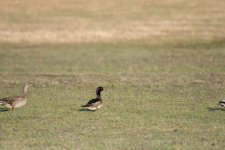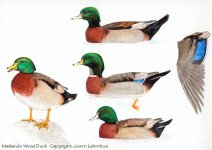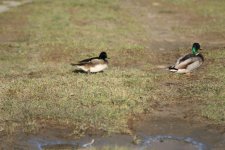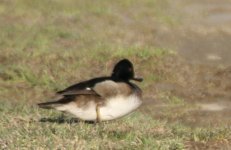-
Welcome to BirdForum, the internet's largest birding community with thousands of members from all over the world. The forums are dedicated to wild birds, birding, binoculars and equipment and all that goes with it.
Please register for an account to take part in the discussions in the forum, post your pictures in the gallery and more.
You are using an out of date browser. It may not display this or other websites correctly.
You should upgrade or use an alternative browser.
You should upgrade or use an alternative browser.
Duck ID Vt. USA (1 Viewer)
- Thread starter steveo
- Start date
More options
Who Replied?Larry Lade
Moderator
It looks like another Mallard X ??? hybrid.
Very bizarre-looking duck! I'll stay on the sidelines, but I'll add that I think Twite is onto something with male Wood Duck hybrid - note vertical white bar with rufous in front, seemingly drooping *almost*-crest, the longish tail... flank coloration is pale, though not in line with Wood Duck coloration. Bill is strange as well.
Steveo, if you alone have found this duck, I sincerely think it's worth being put up on a listserv - Frontiers of ID (BIRDWG01) is good a good place where experts can comment on real stumpers. Check it out:
http://listserv.arizona.edu/archives/birdwg01.html
Steveo, if you alone have found this duck, I sincerely think it's worth being put up on a listserv - Frontiers of ID (BIRDWG01) is good a good place where experts can comment on real stumpers. Check it out:
http://listserv.arizona.edu/archives/birdwg01.html
Yes, I vote for Wood Duck x Mallard cross also. According to the BNA account (http://bna.birds.cornell.edu/bna/species/169/articles/systematics) crosses between these species are not uncommon either in captivity or in the wild. Here's an example: http://www.charliesbirdblog.com/~charlie/mankymallards/Woodmallard.jpg
Joern Lehmhus
Well-known member
I agree on Wood duck hybrid, but....Are there more photos available, Steveo
It does not look like mallard x Wood duck for me from this photo.It has a violet head gloss and the undertail coverts are white, also the mantle/scapulars etc is very dark.
This differs from any other Mallard x wood duck i have seen so far (And there doesn´t seem to be that much variance in this hybrid)
see this for comparison: 4 slightly differing types of hybrids wood duck x mallard:
It does not look like mallard x Wood duck for me from this photo.It has a violet head gloss and the undertail coverts are white, also the mantle/scapulars etc is very dark.
This differs from any other Mallard x wood duck i have seen so far (And there doesn´t seem to be that much variance in this hybrid)
see this for comparison: 4 slightly differing types of hybrids wood duck x mallard:
Attachments
Joern Lehmhus
Well-known member
I did not want to get to close a scare them away hence the bad photos. Hope these help.
Pouha- I think that is a hybrid i havn´t encountered yet- definitely it is not mallard x woodie in my opinion!
searching for a duck that would fit here....must be something with white undertail coverts
Any more photos or better resolution / bigger size might help .I will send you a PM.
ovenbird43
Well-known member

wood duck x mallard was certainly my first impression... though I don't have great experience IDing duck hybrids
Pouha- I think that is a hybrid i havn´t encountered yet- definitely it is not mallard x woodie in my opinion!
Pouha???
How about a Woodie/Hoodie cross? The bill puts me in mind of a merganser bill and both Wood ducks and Hooded Mergs nest in tree cavities in the same habitat, at least in the north.
Two years ago, I followed a mixed brood of Woodies (4) and Hoodies (2) on a local beaver pond. The brood was raised by a hen Wood duck. In this case I believe the hen Hoodie laid a couple of her eggs in the Woodie nest ala cowbird or cuckoo style. Nest holes are in short supply in this back country and this may have been her solution to the local housing dilemma.
I don't know if Wood ducks and Hooded Mergs are close enough genetically to produce offspring or not.
Two years ago, I followed a mixed brood of Woodies (4) and Hoodies (2) on a local beaver pond. The brood was raised by a hen Wood duck. In this case I believe the hen Hoodie laid a couple of her eggs in the Woodie nest ala cowbird or cuckoo style. Nest holes are in short supply in this back country and this may have been her solution to the local housing dilemma.
I don't know if Wood ducks and Hooded Mergs are close enough genetically to produce offspring or not.
Last edited:
Quercus
homo sarkensis
Can we go back to basics here?... I'm confused!
When confronted with an unusual looking duck, the debate goes into the most unlikely sounding hybrids, not only between closely related species, but different genuses ( Anas x Aix etc)
This makes me question the whole subject of not just what is a species, but what is a genus. How genetically seperate is it possible to be, while still being able to produce offspring?
However...... an unusual looking chiffchaff prompts a squable about far flung regional races, but not a word about the possibility of hybridisation with (seemingly) closely related species, not to mention other warbler genuses. Or even a bit of "normal" genetic variation.
Sorry for going off post... but I can't be the only one getting confused here!
When confronted with an unusual looking duck, the debate goes into the most unlikely sounding hybrids, not only between closely related species, but different genuses ( Anas x Aix etc)
This makes me question the whole subject of not just what is a species, but what is a genus. How genetically seperate is it possible to be, while still being able to produce offspring?
However...... an unusual looking chiffchaff prompts a squable about far flung regional races, but not a word about the possibility of hybridisation with (seemingly) closely related species, not to mention other warbler genuses. Or even a bit of "normal" genetic variation.
Sorry for going off post... but I can't be the only one getting confused here!
Can we go back to basics here?... I'm confused!
When confronted with an unusual looking duck, the debate goes into the most unlikely sounding hybrids, not only between closely related species, but different genuses ( Anas x Aix etc)
This makes me question the whole subject of not just what is a species, but what is a genus. How genetically seperate is it possible to be, while still being able to produce offspring?
However...... an unusual looking chiffchaff prompts a squable about far flung regional races, but not a word about the possibility of hybridisation with (seemingly) closely related species, not to mention other warbler genuses. Or even a bit of "normal" genetic variation.
Sorry for going off post... but I can't be the only one getting confused here!
It can be very confusing! :eek!:
You have to remember that all these categorizations are imposed by humans, and humans' evaluation of the genetics. It's not so black and white as we sometimes make it out to be. While Anas may be close enough to crossbread with Mergus or Aix, there are certain genetic markers which are unique to Anas... *squirms in seat* This gets into the world (which as of yet I haven't fully grasped) of monophyletic groups vs. paraphyletic groups. You may want to do some Wikipedia reading:
http://en.wikipedia.org/wiki/Paraphyletic
http://en.wikipedia.org/wiki/Monophyletic
http://en.wikipedia.org/wiki/Anas#Systematics
Joern Lehmhus
Well-known member
Pouha???
just an expression of great astonishment...
Joern Lehmhus
Well-known member
Can we go back to basics here?... I'm confused!
When confronted with an unusual looking duck, the debate goes into the most unlikely sounding hybrids, not only between closely related species, but different genuses ( Anas x Aix etc)
This makes me question the whole subject of not just what is a species, but what is a genus. How genetically seperate is it possible to be, while still being able to produce offspring?
However...... an unusual looking chiffchaff prompts a squable about far flung regional races, but not a word about the possibility of hybridisation with (seemingly) closely related species, not to mention other warbler genuses. Or even a bit of "normal" genetic variation.
Sorry for going off post... but I can't be the only one getting confused here!
Alex has already partly answered to that- the main thing to remember here is that the definitions are created by humans which like to have things neat and tidy.
- in respect to ducks , there are many pairings possible which often result in hybrids, even between quite distant genera.
However if the genera are distant , the hybrids are sterile and can´t produce offspring.
Within one genus, the hybrids between different species seem to be fertile in most cases. for exampe: Anas platyrhynchos, mallard x Anas acuta, pintail produces fertile hybrid offspring which can produce 2nd generation hybrids or backcrosses with either parent species.
However , such hybrids are very rare-the species are seperated behaviourally(though not genetically)- But as there are differences in display behaviour between different species of ducks, these (normally) prevent hybridisation.
By the way, I think we should take in consideration also Mallard x Hooded merganser as has been proposed already.
i am not convinced why it should be hoodie x woodie...could you explain why you think so; Vinch?
Users who are viewing this thread
Total: 2 (members: 0, guests: 2)







